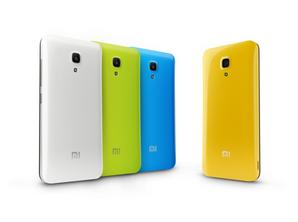He’s being dubbed “China’s Steve Jobs,” so will plastic smartphones give a little Apple-sparkle to Lei Jun’s Xiaomi?
He wears a black polo shirt with his jeans, instead of a black turtle neck. And his footwear is Converse, not New Balance. But the image is carefully cultivated. Lei Jun, CEO of China-based Xiaomi Inc. wants to be China’s Steve Jobs. The company he founded in Beijing less than four years ago already has over 3,000 employees and revenue in 2013 of 6.25 billion euros ($8.6 billion). It works on a direct sales model, selling its smartphones only from its own “experience” stores and its website.
The company’s range of smartphones has been a hit in Xiaomi’s native China since the release of its first phone, the Mi-One in December 2011, and the company is now diversifying into network drives and smart TVs.
Like the company Jun hopes to emulate, Xiaomi has gone “beautifully, unapologetically plastic” — to borrow a phrase used by Apple’s design chief, Jonathan Ive, on the launch of the iPhone 5c — with the design of its Mi2A smartphone. The slimline phone is available in a palette of bright and strangely familiar colors (note, however, that Mi2A launched some months before the iPhone 5c and may outlive the phone, which Apple watchers consider a failure).
To achieve the required effect, Xiaomi turned to Sabic Innovative Plastics, the Saudi Arabia-based polymer producer, selecting its polycarbonate grades Thermocomp LDS and Lexan EXL. Why did Xiaomi opt for these particular grades?
“Each of the three Sabic materials chosen for this application are PC based,” said Matt Gray, consumer electronics market director for Sabic. “However, each resin and compound has been specially formulated with additives and fillers, using proprietary Sabic processes, to achieve the desired performance based on the requirements of the application.
“Sabic’s Thermocomp DX10311 — a glass fiber reinforced PC — was chosen for the internal frame as it delivered the balanced mechanical properties required by the customer, such as stiffness and strength, as well as good impact resistance. The Thermocomp DX10311 compound was also found to be particularly suitable for this application as it helped to provide a surface that enabled a high yield rate for non-conductive vacuum metallization and painting, two processes that are often used on device frames.”
To keep the form of the Mi2A slim, its antenna is integrated into the frame. This necessitated a sophisticated manufacturing process, laser direct structuring, or LDS, to integrate electronics and mechanical functions into a single part.
“Sabic specially developed this compound to be a good candidate for applications requiring the LDS process, which can help enable design flexibility and space consolidation that can ultimately help device makers to reduce the depth of a phone to less than 10mm, and to meet the industry trend towards thinner, more lightweight technology.’
The glossy “unapologetically plastic” back case was molded from Lexan EXL1414 resin. Gray said: “Lexan EXL1414 copolymer resin is a medium flow opaque injection-molding grade. It was chosen for the battery cover/back of the phone because it enables a variety of rich color options, helping manufacturers to design an aesthetically pleasing smartphone housing with colors that meet the demands of consumers.”
He said the material has other important features, including superior impact resistance, low temperature ductility (down to -40°C) and chemical resistance. It also enables shorter injection molding cycle times when compared to standard PC resins.
The Xiaomi Mi2A smartphone was introduced to the Chinese market in May 2013. It has not yet been officially imported into the European market, although grey-market imports are available from online retailers.
James Snodgrass
EUROPEAN PLASTICS NEWS
Published: April 8, 2014 5:09 pm ET
Updated: April 8, 2014 5:14 pm ET

Image By: Sabic Innovative Plastics
China's Xiaomi debuted its plastic smartphone before Apple's iPhone 5c, and is continuing to find success with it.
| 